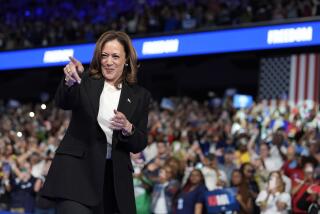Voter Turnout Nationwide Is Equal to ’86 Low
- Share via
Experts estimated that only about 36% of eligible Americans turned out to vote Tuesday, matching the lowest total of the past 50 years.
Curtis B. Gans, director of the Committee for the Study of the American Electorate, a Washington-based group that studies voting trends, said that preliminary calculations showed turnout almost exactly equal to the 36.4% in 1986, a post-World War II low.
But that figure masked wide variations across the country. Relative to 1986, the last midterm election, turnout was up substantially in Massachusetts, the site of a closely contested gubernatorial race; North Carolina, where conservative Republican Sen. Jesse Helms turned back a black Democratic challenger, Harvey Gantt; and Minnesota, which saw tight struggles for both governor and senator. A higher percentage of eligible voters also came to the polls in Kentucky, the District of Columbia, Maine, Connecticut, Ohio and Iowa.
On the other hand, California, New York and Florida all saw substantial declines. Preliminary figures assembled by Gans indicate that only 32.7% of eligible voters came out in California (though he cautions that final calculations may slightly raise the total), just 29.1% in New York, and 34.6% in Florida. The raucous governor’s race in Texas won by Democrat Ann Richards produced a slight increase in turnout, but only to 30.7%.
Several other states with close races also fell off. “Oregon, Kansas, Alabama, Hawaii, Oklahoma, Illinois--all had highly competitive races and all of them had lower turnouts,” said Gans.
In some states, the turnout pattern appeared to be a key--if not decisive--factor in the results. In Florida, Gov. Bob Martinez suffered from low turnout in heavily Republican areas in his ringing defeat by Democrat Lawton Chiles. In Michigan, Democratic Gov. James J. Blanchard was undercut by low turnout in heavily Democratic Detroit and lost a narrow decision to Republican John Engler.
The repeat of 1986’s meager showing deepened concerns among experts about the apparently inexorable downward trend in electoral participation. “There is no reason to believe the bottom has been reached,” said Sanford Horwitt, director of the Citizen Participation Project at People for the American Way, a liberal Washington group. “This is a continuing, ongoing, decline.”
More to Read
Get the L.A. Times Politics newsletter
Deeply reported insights into legislation, politics and policy from Sacramento, Washington and beyond. In your inbox twice per week.
You may occasionally receive promotional content from the Los Angeles Times.









